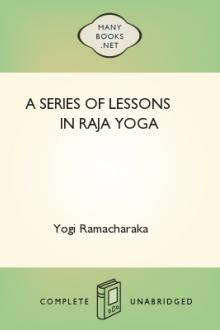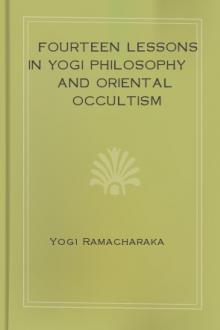A Series of Lessons in Raja Yoga by William Walker Atkinson (pdf ebook reader TXT) 📖

- Author: William Walker Atkinson
- Performer: 0766127001
Book online «A Series of Lessons in Raja Yoga by William Walker Atkinson (pdf ebook reader TXT) 📖». Author William Walker Atkinson
"It shall grow, it will shoot up, it will make branches and leaves, and form buds while the storm lasts. But not until the entire personality of the man is dissolved and melted—not until it is held by the divine fragment which has created it, as a mere subject for grave experiment and experience—not until the whole nature has yielded and become subject unto its higher self, can the bloom open. Then will come a calm such as comes in a tropical country after the heavy rain, when nature works so swiftly that one may see her action. Such a calm will come to the harassed spirit. And in the deep silence the mysterious event will occur which will prove that the way has been found. Call it by whatever name you will. It is a voice that speaks where there is none to speak, it is a messenger that comes—a messenger without form or substance—or it is the flower of the soul that has opened. It cannot be described by any metaphor. But it can be felt after, looked for, and desired, even among the raging of the storm. The silence may last a moment of time, or it may last a thousand years. But it will end. Yet you will carry its strength with you. Again and again the battle must be fought and won. It is only for an interval that nature can be still."
* * * * *
The concluding three lessons of this series will be devoted to a practical course of instruction in the development of the hidden planes of the mind, or rather, in the development of the power of the individual to master the same and make use of them in his life. He will be taught to master the lower principles, not only in the surmounting of them, but in the transmitting of the elemental forces toward his higher ends. Power may be obtained from this part of the mind, under the direction of the Will. And the student will be told how to set the unconscious Intellect to work for him. And he will be told how to develop and train the Will. We have now passed the line between the theoretical and the practical phases of the subject, and from now on it will be a case of train, develop, cultivate and apply. Knowing what lies back of it all, the student is now prepared to receive the instructions which he might have misused before. Peace be with thee all.
MANTRAM (AFFIRMATION). I AM THE MASTER OF MY SOUL. THE TENTH LESSON. SUB-CONSCIOUSING.In the Ninth Lesson we called your attention to the fact that Reasoning was not necessarily conscious in its operations, and that, in fact, a large part of the rational processes of the mind are performed below or above the field of consciousness. And in the Eighth Lesson we gave you a number of examples illustrating this fact. We also gave you a number of cases in which the sub-conscious field of the Intellect worked out problems, and then after a time passed on to the conscious field of the Intellect the solution of the matter. In this lesson we purpose instructing you in the methods by which this part of the Intellect may be set to work for you. Many have stumbled upon bits of this truth for themselves, and, in fact, the majority of successful men and men who have attained eminence in any walk of life have made more or less use of this truth, although they seldom understand the reason of it.
Very few Western writers have recognized the work of this plane of the mind. They have given us full and ingenious theories and examples of the workings of the Instinctive Mind, and in some cases they have touched upon the workings and operations of the Intuitional planes, but in nearly every case they have treated the Intellect as something entirely confined to the Conscious plane of mentation. In this they have missed some of the most interesting and valuable manifestations of sub-conscious mentation.
In this lesson we will take up this particular phase of mentation, and trust to be able to point out the way to use it to the best advantage, giving some simple instructions that have been given by the Hindu teachers to their students for centuries past, such instructions of course, being modified by us to conform to the requirements and necessities of the Western student of today.
We have taken the liberty of bestowing a new title upon this phase of mentation—we have thought it well to call it "Sub-consciousing." The word "Sub," of course means "under; below;" and the word "Consciousing" is a favorite term employed by Prof. Elmer Gates, and means receiving impressions from the mind. In a general way, "Sub-consciousing," as used in this lesson, may be understood to mean "using the subconscious mind, under orders of the conscious mind."
By referring to our Eighth Lesson, we see mention made of the case of the man who indulged in "unconscious rumination," which happened to him when he read books presenting new points of view essentially opposed to his previous opinion. You will note that after days, weeks, or months, he found that to his great astonishment the old opinions were entirely rearranged, and new ones lodged there.
On the same page you will see mentioned the case of Sir William Hamilton, who discovered an important law of mathematics while walking with his wife. In this case he had been previously thinking of the missing link in his chain of reasoning, and the problem was worked out for him by the sub-conscious plane of his Intellect.
On the same page, and the one following, is found the case of Dr. Thompson, who gives an interesting account of the workings of this part of his mind, which caused him at times to experience a feeling of the uselessness of all voluntary effort, coupled with a feeling that the matter was working itself clear in his mind. He tells us that at times he seemed to be merely a passive instrument in the hands of some person other than himself, who compelled him to wait until the work was performed for him by some hidden region of the mind. When the subconscious part of the mind had completed its work, it would flash the message to his conscious mind, and he would begin to write.
On page 178 mention is also made of the great French chemist Berthelot, who relates that some of his best conceptions have flashed upon him as from the clear sky. In fact, the Eighth Lesson is largely made up of examples of this kind, and we ask the student to re-read the same, in order to refresh his mind with the truth of the workings of the sub-conscious mentality.
But you will notice in nearly all the cases mentioned, that those who related instances of the help of the sub-conscious mind had merely stumbled upon the fact that there was a part of the mind below consciousness that could and would work out problems for one, if it could somehow be set in operation. And these people trusted to luck to start that part of the mind in operation. Or rather, they would saturate their conscious mind with a mass of material, like stuffing the stomach with food, and then bid the subconscious mind assort, separate, arrange and digest the mental food, just as does the stomach and digestive apparatus digest the natural food—outside of the realm of consciousness or volition. In none of the cases mentioned was the subconscious mind directed specially to perform its wonderful work. It was simply hoped that it might digest the mental material with which it had been stuffed—in pure self defense. But there is a much better way, and we intend to tell you about it. The Hindu Yogis, or rather those who instruct their pupils in "Raja Yoga," give their students directions whereby they may direct their sub-conscious minds to perform mental tasks for them, just as one may direct another to perform a task. They teach them the methods whereby, after having accumulated the necessary materials, they may bid the sub-conscious mentality to sort it out, rearrange, analyze, and build up from it some bit of desired knowledge. More than this, they instruct their pupils to direct and order the sub-conscious mentality to search out and report to them certain information to be found only within the mind itself—some question of philosophy or metaphysics. And when such art has been acquired, the student or Yogi rests assured that the desired result will be forthcoming in due time, and consequently dismisses the matter from his conscious mind, and busies himself with other matters, knowing that day and night, incessantly, the sub-consciousing process is going on, and that the sub-conscious mind is actively at work collecting the information, or working out the problem.
You will see at once the great superiority of this method over the old "hit-or-miss," "hope-it-will-work" plan pursued by those who have stumbled upon bits of the truth.
The Yogi teacher begins by impressing upon his students the fact that the mind is capable of extending outward toward an object, material or mental, and by examining it by methods inherent in itself, extracting knowledge regarding the object named. This is not a startling truth, because it is so common, everyone employing it more or less every day. But the process by which the knowledge is extracted is most wonderful, and really is performed below the plane of consciousness, the work of the conscious mind being chiefly concerned in holding the Attention upon the object. We have spoken of the importance of Attention in previous lessons, which it will be well for you to re-read, at this time.
When the student is fully impressed with the details of the process of Attention, and the subsequent unfoldment of knowledge, the Yogi proceeds to inform him that there are other means of obtaining knowledge about an object, by the employment of which the Attention may be firmly directed toward the object and then afterwards held there unconsciously—that is, a portion of the Attention, or a sub-conscious phase of mentation, which will hold the sub-conscious mind firmly upon the work until accomplished, leaving the conscious Attention and mentality free to employ itself with other things.
The Yogis teach the students that this new form of Attention is far more intense and powerful than is the conscious Attention, for it cannot be disturbed or shaken, or distracted from its object, and that it will work away at its task for days, months, years, or a lifetime if necessary, according to the difficulty of the task, and in fact carries its work over from one life to another, unless recalled by the Will. They teach the student that in everyone's life there is going on a greater or less degree of this sub-conscious work, carried on in obedience to a strong desire for knowledge manifested in some former life, and bearing fruit only in the present existence. Many important discoveries have been made in obedience to this law. But it is not of this phase of the matter that we wish to speak in this lesson.
The Yogi theory is that the sub-conscious intellectual faculty may be set to work under the direction of orders given by the Will. All of you know how the sub-conscious mentality will take up an order of the Will, or a strong wish, that the person be awakened at a certain hour in order to catch a train. Or, in the same way how the remembrance of a certain engagement at, say, four o'clock, will flash into the mind when the hands of the clock approach the stated hour. Nearly every one can recall instances of this sort in his own experience.
But the Yogis go much further than this. They claim that any and all faculties of the mind may be "set going," or working on any problem, if ordered thereto by the Will. In fact, the Yogis, and their advanced students have mastered this art to such a surprising extent that they find it unnecessary to do the drudgery of thinking in the conscious field, and prefer to relegate such mental work to the sub-conscious, reserving their conscious work for the consideration of digested information and thought presented to them by the sub-conscious mind.
Their directions to their students cover a great deal of ground, and extend over a long period of time, and many of the directions are quite complicated and full of detail. But we think





Comments (0)